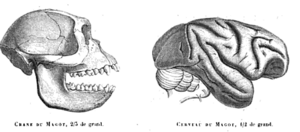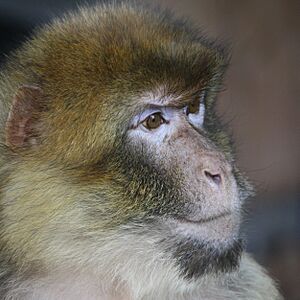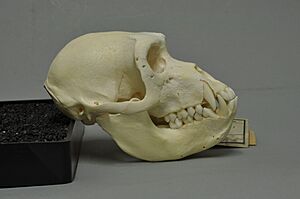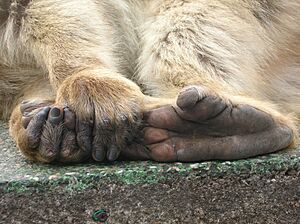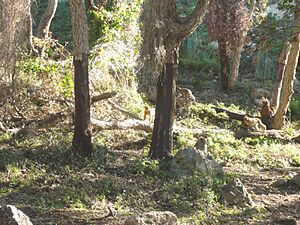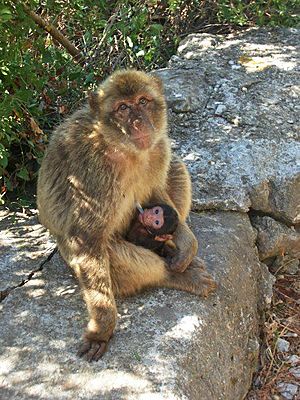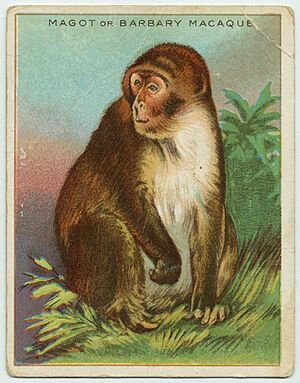Barbary macaque facts for kids
Quick facts for kids Barbary macaque |
|
|---|---|
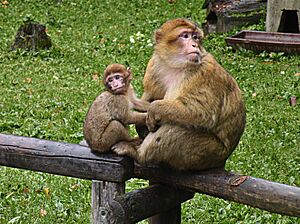 |
|
| Young Barbary macaque with its mother | |
| Conservation status | |
| Scientific classification | |
| Genus: |
Macaca
|
| Species: |
sylvanus
|
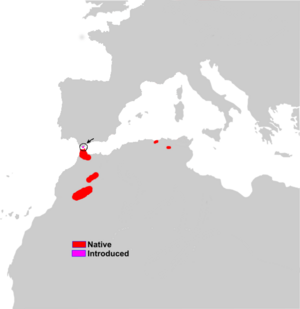 |
|
| Native Range in Red (Northeast Africa); Introduced Range in Violet (Gibraltar) | |
| Synonyms | |
|
Simia sylvanus Linnaeus, 1758 |
|
The Barbary macaque (Macaca sylvanus), also called the Barbary ape, is a type of macaque monkey. It naturally lives in the Atlas Mountains of Algeria, Tunisia and Morocco. There is also a small group living in Gibraltar that was brought there by humans.
These monkeys are special because the males help a lot with raising the babies. Since it's hard to know which male is the father, all the males help care for all the young. Both male and female Barbary macaques of all ages help look after the young ones.
Barbary macaques mostly eat plants and insects. They can live in many different places. Males usually live to about 25 years old, while females can live up to 30 years. Besides humans, they are the only wild primates living in Europe. Even though they are often called "Barbary apes," they are actually true monkeys. Their name comes from the Barbary Coast in Northwest Africa.
The group of Barbary macaques in Gibraltar is the only one outside Northern Africa. It is also the only group of wild monkeys in Europe. Long ago, Barbary macaques lived in many parts of Europe, even as far north as England. About 300 macaques live on the Rock of Gibraltar today. This group seems to be growing, but the groups in North Africa are shrinking.
Contents
About the Barbary Macaque
The Barbary macaque was first written about by Aristotle around 300 BCE. He described an ape with "arms like a man" and "feet like large hands." Later, a doctor named Galen (who lived around 129–216 CE) likely studied Barbary macaques. He thought their insides were the same as humans.
In 1758, Carl Linnaeus gave the Barbary macaque its scientific name, Simia sylvanus. Over time, scientists changed how they classified this monkey. Eventually, it was placed in the genus Macaca, which is what we use today.
Family Tree of Macaques
The Barbary macaque is the oldest type of macaque. Studies show it is a "sister group" to all the macaque species found in Asia. This means it branched off from the main macaque family tree before the Asian macaques did.
| Phylogeny of ten species of Macaca | ||||||||||||||||||||||||||||||||||||||||||||||||||||||||||||||||||||||||
|---|---|---|---|---|---|---|---|---|---|---|---|---|---|---|---|---|---|---|---|---|---|---|---|---|---|---|---|---|---|---|---|---|---|---|---|---|---|---|---|---|---|---|---|---|---|---|---|---|---|---|---|---|---|---|---|---|---|---|---|---|---|---|---|---|---|---|---|---|---|---|---|---|
|
Ancient History
Barbary macaque fossils have been found all over Europe. They date from about 5.3 million years ago to more recent times. Remains found in England show they lived as far north as 53 degrees latitude. This is one of the most northern places non-human primates have been found. The youngest remains in Europe are from Germany, dating back 85,000 to 40,000 years ago. Their presence in Europe likely depended on the climate. They moved north during warmer periods and stayed in southern areas when it was colder. Some scientists think humans might have caused their disappearance from Europe.
What They Look Like
The Barbary macaque has a dark pink face. Its fur can be pale buff, golden brown, or grey. Its underside is lighter. The color of older adults changes as they age. In spring and early summer, they shed their thick winter fur.
Male Barbary macaques are larger than females. Males are about 63.4 cm long, and females are about 55.7 cm long. They have a very short tail, or sometimes no tail at all. It measures only 4–22 mm. Males weigh about 14.5–16 kg, and females weigh about 9.9–11 kg.
Like all Old World monkeys, they have tough sitting pads on their rear. Females show swelling when they are ready to mate. They also have cheek pouches to store food.
Where They Live
Historically, Barbary macaques lived across North Africa. They are the only African primates found north of the Sahara Desert. Today, they mainly live in scattered areas of the Rif and Atlas Mountains in Morocco and Algeria. They prefer higher elevations, from 400 to 2300 meters. The groups in Morocco and Algeria are about 700 km apart.
Barbary macaques also live in Gibraltar, at the southern tip of Europe. They have been there for a very long time. It is believed that the Moors brought them from North Africa to Gibraltar during the Middle Ages. During World War II, Winston Churchill even ordered more macaques to be brought to Gibraltar to help their numbers grow. Today, there are about 300 Barbary macaques in Gibraltar.
They can live in different types of places. These include cedar, fir, and oak forests, grasslands, and rocky areas with plants. In Morocco, many live in Atlas cedar forests. In Algeria, they live in mixed cedar and oak forests.
Fossils show that Barbary macaques lived in southern Europe during past warmer periods. They even lived in England. An ancient Greek writer mentioned them in Tunisia, meaning they died out there about 2,500 years ago.
Behavior and Life
Barbary macaques live in groups with several females and males. These groups can have 10 to 100 monkeys. The females lead the group, and their rank depends on their family line. Unlike other macaques, the males help raise the young. Males spend a lot of time playing with and grooming the babies. This creates strong bonds between males and all the young, whether they are their own or not. Females might choose males who are good at parenting.
The mating season is from November to March. Pregnancy lasts about 147 to 192 days. Females usually have one baby at a time, but sometimes they have twins. Babies become adults at three to four years old. They can live for 20 years or more.
Social Life
When Barbary macaques groom each other, it helps lower stress for the monkey doing the grooming. Grooming more monkeys leads to even lower stress levels. This benefit might be worth the time spent grooming, even if it means less time for other things like finding food. Grooming helps them build strong social relationships.
Male Barbary macaques help each other in fights. They form groups, often with male relatives. This helps them improve their own chances of having babies. They are more likely to help close relatives than distant ones. These groups are not permanent and can change often. Males try to avoid fighting with higher-ranking males. They will often join the higher-ranking male in a conflict.
Males often gather closely when baby macaques are around. Interactions between males often start when one male shows a baby to another adult male. This behavior helps reduce fights among males in the group. When a Barbary macaque opens its mouth, especially a young one, it usually means they want to play.
Communication
Barbary macaques make calls to warn others about dangers, like predators. They can tell the difference between calls from their own group and calls from other groups. The way they make calls can change based on the monkeys they are with and the social situation.
Female Barbary macaques can recognize their own baby's calls. This means baby calls don't have to be very different for mothers to know their own. Mothers act differently when they hear their own baby's call compared to other babies' calls.
Mating and Parenting
Barbary macaque females often mate with many males in their group. While females do choose mates, the mating behavior is not only decided by the females. When females mate with many males, it makes it harder for males to know if they are the father. This might be why males care for all the babies in the group. To have more babies, a male needs to spend a lot of time around females when they are fertile. Males get more injuries during this time, showing that males compete to mate.
All Barbary macaques, no matter their age or sex, help care for the babies. Male care for babies is very interesting because it's rare for males to help so much when they are not sure if they are the father. Males even carry and care for babies for hours. Higher-ranking females have more interactions with babies, while younger, lower-ranking females have less access.
What They Eat
The Barbary macaque eats a mix of plants and insects. They eat many different types of plants. They eat almost every part of a plant, including flowers, fruits, seeds, leaves, and roots. They also catch and eat snails, earthworms, spiders, grasshoppers, and beetles.
Barbary macaques can damage cedar trees in Morocco by stripping their bark. This is a problem because deforestation is a big issue there. Cedar trees are important for these monkeys, as areas with cedars can support more macaques. A lack of water or being kept away from water sources can cause them to strip bark.
Who Hunts Them
The main predators of the Barbary macaque are domestic dogs, leopards, and eagles. Golden eagles might only hunt baby macaques. When eagles or dogs come near, the macaques make alarm calls to warn the group.
Threats to Barbary Macaques
Wild Barbary macaque populations have shrunk a lot recently. They are now listed as an endangered species since 2008. Their forest homes are being broken up and destroyed. They are also caught illegally to be sold as pets. Sometimes, they are killed for raiding crops.
Today, we don't know exactly how many Barbary macaques live outside their natural habitat. Many are in zoos, private homes, or waiting to be moved.
Their habitat is threatened by more logging. Local farmers see them as pests and try to get rid of them. Once, they lived all over North Africa and southern Europe. Now, only about 12,000 to 21,000 are left in Morocco and Algeria. Their living areas are no longer connected, only small, isolated spots remain. They disappeared from most of Europe around 30,000 years ago.
Besides habitat loss and illegal capture, too much overgrazing by livestock also harms them. In Morocco, tourists often interact with Barbary macaques. People in the High Atlas mountains have said that macaques are captured there. Conflicts between local people and wild macaques are a big problem for their survival. This is mainly because the monkeys raid crops.
However, macaques also help the environment. They eat harmful insects and help spread seeds of many plants. In some areas, macaques attract many tourists, which can bring money to the region.
Humans and Tourism
In Morocco, macaques are often used for tourist photos, even though they are protected. Tourists pay to take pictures with them. Macaques are also sold as pets in Morocco and Algeria. They are even sent to Europe to be pets or fighting monkeys.
When tourists get too close to wild monkeys, it can stress the animals. Studies show that the presence of tourists has a negative effect on macaques. Taking photos can stress them, possibly because people get too close or stare (which is a sign of aggression for primates). Macaques living near humans often have more parasites and are less healthy. This is partly because they eat unhealthy human food.
Scientists compared two groups of Barbary macaques in Morocco. One group lived near tourists, and the other lived in the wild. The tourist group spent more time resting and being aggressive. They spent less time looking for food and moving. The tourist group ate human food for 26% of their daily meals, while the wild group ate human food only 1% of the time.
The Barbary macaque has been traded or given as gifts for a very long time. Remains have been found in ancient sites in Ireland, Luxembourg, and Roman sites in Britain.
See also
- Djebel Babor Nature Reserve
- Trentham Monkey Forest
- Celebes crested macaque



